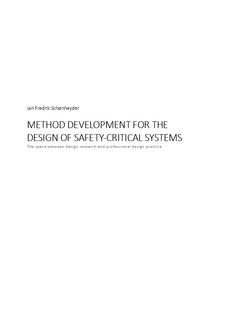Method development for the design of safety-critical systems
Abstract
A common field in academic research is the development and refinement of design methods with the aim of supporting professional design practice. As a result, design practitioners have a wide range of methods and tools at their disposal. However, some studies have shown that the design methods developed through research are not always adopted or used by professional designers. This lack of recognition has been seen as a problem for design researchers. At the same time, practitioners express that researchers do not address the problems of real-world practice and that most methods developed through research are irrelevant or inapplicable because of their failure to consider real-world constraints.
This industrial PhD thesis explores this problem from an insider’s perspective at Halogen, a Norwegian design company. Focusing on interaction and systems design, Halogen specializes in safety-critical systems, a field in which poor design might result in the loss of human lives or damage to the environment and the economy. Here, design practitioners interact with the industry, professional users and legislative authorities, often represented by the scientific community of human factors. However, little or no research can be found on how designers use design methods in this particular context.
This problem will be addressed by approaching research as a design practice using the interaction design research triangle. A first-person perspective will be used; I will observe and participate with designers in their everyday professional practice. This approach is guided by the overarching aim to investigate, in-situ, how design methods for safety-critical systems can be improved. Central to this approach is the use of the philosophy of pragmatism to understand and explain design methods in a real-world context. The study produced three journal articles that contrast and builds on existing literature on design methods and practice. A proprietary method collection was additionally developed for Halogen to support and assess the translation of analysis to the design of safety-critical systems.
The contribution of this thesis falls into two categories: (1) It offers a theoretical framework for explaining how professional designers use design methods in an unfamiliar, high-risk domain. The theoretical framework could enable further development and evaluation of design methods in the context of real-world design. (2) It offers a mutual framework to help improve the relationship between design researchers and practitioners. Based on pragmatism and a modified interaction design research triangle, the proposed framework overarches the work in this thesis. Combined, the two contributions form new opportunities for research and practice to understand and improve methods for the design of safety-critical systems.
